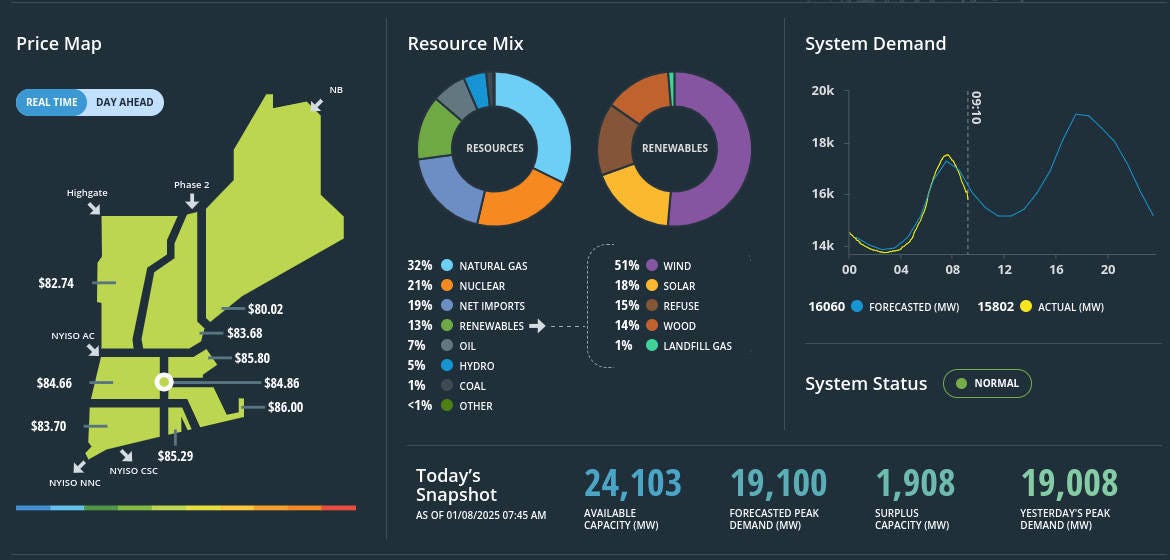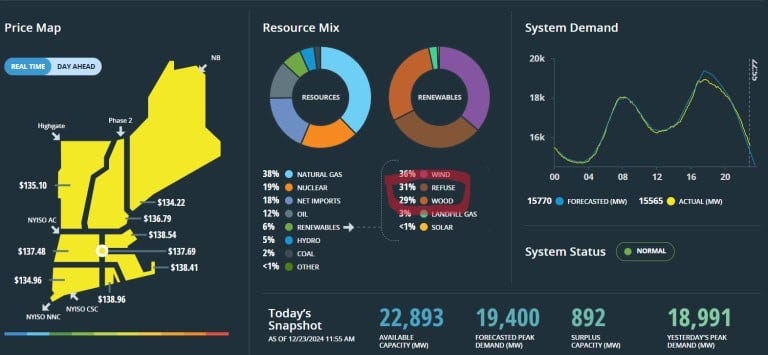“Green” New England Burns NatGas, Coal, Oil to Keep the Lights On”
“For years, New England states like Massachusetts, Vermont, and Connecticut have blocked new natural gas pipelines that would carry Marcellus molecules from a few hundred miles away into their state…”
“Green” New England Burns NatGas, Coal, Oil to Keep the Lights On
ANTI-DRILLING/FOSSIL FUEL | ELECTRICAL GENERATION | INDUSTRYWIDE ISSUES
January 8, 2025
Liberal New England, one of the bluest (Democrat) areas of the country, continues to do the opposite of what they preach. For years, New England states like Massachusetts, Vermont, and Connecticut have blocked new natural gas pipelines that would carry Marcellus molecules from a few hundred miles away into their states, claiming they seek to phase out fossil energy to be more “green.” Yet, as of this morning, 41% of the electricity flowing through New England’s grid comes from fossil fuels—natural gas (33%), oil (7%), and coal (1%). Another 4% comes from burning garbage and wood, which emits as much or more carbon dioxide as fossil fuels! How much electricity is being produced from solar and wind right now in New England? A piddly 9%.
Here’s the ISO New England (grid operator) dashboard as of this morning, showing the sources used to make the region’s electricity. This is apart from the enormous amounts of natural gas and fuel oil used in furnaces to keep homes and businesses warm.
Some of the natural gas used in New England is not domestically sourced! Some of it is imported as LNG from Trinidad. The Jones Act, passed in 1920, prevents LNG shipments from U.S. port to U.S. port. It’s obscene.
Anyway, what got us thinking about New England and its lack of cheap, abundant Marcellus gas was a couple of posts we recently read.
From the blog site Grok! New England, a post titled “New England Is Burning Oil and Coal To Keep the Lights On”:
Eagle-eyed New England energy observer Meredith Angwin of Wilder pointed out an inconvenient fact on X this Monday: when it’s cold (like this week) and people are home more than usual (like this week), ‘green’ New England burns oil and coal to make electricity.
“We are having our first real cold snap,” the author of Shorting the Grid said five days ago. “It will get below zero F tonight. And at 4:15 p.m. our grid was already dependent on oil.”
Indeed. According to another Dec. 23 (11;55 AM) ISO-New England energy resource snapshot posted early this week by Angwin, about one one in eight (12%) of all kilowatts were generated by burning oil.
Here’s why. Around 4 PM, many people are home, cooking, washing, viewing TV and computers – in other words, consuming more power than at, say, 4 AM. At these ‘peak’ times on cold days, New England starts to run low on electricity-making natural gas.
The problem isn’t lack of supply. Billions of square ft. of natural gas wait to be ‘wheeled’ through existing pipelines from the nearby Marcellus shale natural gas fields in New York and Pennsylvania.
The problem is transportation. Climate-minded New England energy legislators and regulators, prompted by climate change advocacy organizations, have stalled efforts to build more pipeline capacity.
Natural gas is a dual-purpose fuel. Across New England it’s the #1 electricity fuel and the #2 heating fuel (after heating oil and kerosene).
Thanks to Vermont’s large, hard-working, decentralized network of heating oil fuel dealers, and the renewable-preferring state government’s opposition to extending natural gas lines, heating fuels like oil, propane and kerosene provide about 59% of the Green Mountain State’s heat. Gas is just 18%, most of it in northwestern Vermont.
However, the more populous southern New England states are far more reliant on natural gas to stay warm. When the mercury falls in Massachusetts, Rhode Island, and Connecticut, there’s not enough natural gas to go around.
As the temps plummet, southern New Englanders turn up the heat and turn on their appliances (they’re inside, remember?). If natural gas was their only option, energy operators and regulators face a Sophie’s Choice: keep ‘em warm, or keep on the electricity?
Of course, choosing between freezing and darkness is unacceptable. So the operators (maybe) ask homeowners to conserve, and then prioritize natural gas supplies to keep people warm. ISO-New England, the regional electricity grid, picks up the electricity slack by burning other fuels. Fuels like coal and oil.
There was a time, just over a decade ago, that New England could rely on four nuclear power plants to provide 24/7/365 low cost, zero-carbon electricity. But when the powerful renewable industry and friendly lawmakers and regulators prevented new utility contracts with Vermont Yankee and Pilgrim (Plymouth, MA), those plants were quite intentionally thrown on the mercy of the natural-gas glutted open market.
Those closures left only Seabrook in New Hampshire and Millstones 1&2 in Connecticut. Efforts to build high-transmission lines from Canada, and offshore wind, have not born fruit. Coal-burning plants too have been shut down. But still the grid carries enough ‘emergency’ oil and coal-burning generation to keep the lights on – barring a perfect storm of a severe Polar Vortex and unforeseen fuel transportation and electricity transmission problems.
In bullet-point form, here’s an overview of New England’s cold-weather energy challenges, and possible solutions.
1. Pipeline Constraints and Energy Access
Pipeline Development Opposition: The lack of sufficient natural gas pipeline infrastructure in New England has created bottlenecks, even though the region is geographically close to abundant gas resources in the Marcellus Shale. Resistance to building pipelines often stems from environmental concerns, land use conflicts, and local opposition.
Import Reliance: Due to pipeline constraints, New England sometimes imports liquefied natural gas (LNG) from overseas, which is typically more expensive than domestic pipeline-delivered gas.
2. Fuel Prioritization During Winter
Residential Heating Priority: Natural gas providers prioritize home heating, which means power plants often struggle to secure enough gas during peak winter demand. This “dual-fuel” system means that many power plants switch to burning oil when natural gas isn’t available.
Environmental and Economic Costs: Using oil for power generation is less efficient and emits more carbon dioxide than natural gas. It’s also subject to price volatility and potential supply challenges.
3. Coal and Nuclear Plant Closures
Like other regions, New England is witnessing the retirement of coal and nuclear plants, which historically provided stable, baseload power. This increases reliance on natural gas and intermittent renewable energy sources.
The loss of nuclear, in particular, removes a significant low-carbon energy source, complicating efforts to decarbonize the grid.
Possible Solutions:
1. Energy Infrastructure Investments
Advocate for carefully planned pipeline expansions to increase access to Marcellus gas, with environmental safeguards to address concerns.
Explore regional LNG storage and delivery options for peak demand periods.
2. Diversification of Energy Sources:
Accelerate investments in renewable energy, like wind and solar, alongside grid-scale battery storage to ensure reliability.
Consider keeping remaining nuclear plants operational where feasible or investing in next-generation nuclear technology.
3. Demand-Side Management:
Encourage energy efficiency measures and demand response programs to reduce peak heating and electricity demand in winter. (1)
From the Competitive Enterprise Institute blog, a post titled “New England relies on oil to keep the Christmas lights on”:
Oil, and the refined products that it produces, has many uses for which it’s incredibly well suited. Being burned in power plants that generally rely on natural gas isn’t one of them. New England is continually plagued by its lack of sufficient natural gas pipeline infrastructure and cold temperatures often require gas plants to run on backup oil because home heating has priority claim on the limited gas.
This Christmas, New England’s grid, ISO New England, is once again relying on oil to make up the difference on the grid. Two years ago, amid freezing temperatures on Christmas Day, the largest source of power generation on the New England grid was oil. There was also a significant amount of oil on the grid on the 23rd and 24th.
This year, the New England grid was 12 percent oil on the 22nd, with lower but still notable oil use on the 23rd and 24th. Seven percent of ISO New England’s resource mix was oil on December 24th.
Writer and power grid expert Meredith Angwin, who lives in Vermont, consistently points out when the power mix in New England includes oil. In her book, Shorting the Grid, she has a chapter called “Oil Saves the Grid.” This chapter outlines the incentives that have led to oil being used in the region’s natural gas power plants when natural gas is unavailable. As New England has relied increasingly on natural gas for power, it has failed to make concomitant investments in natural gas pipelines.
Oil is comparatively expensive as a fuel for power plants and does not burn efficiently in these scenarios. Oil fuel for power plants is almost exclusively used as a stopgap during times of high demand, and for good reason.
New England should take these occasions as a reason to invest in new pipeline capacity, especially as the Jones Act’s requirements that vessels be US-owned, built, crewed, and registered to move goods between two US ports make it nearly impossible to move liquified natural gas (LNG) between US ports because there are no LNG tankers that meet these requirements. This means that pipelines remain New England’s best option for timely LNG delivery.
Although pipeline development is a fraught issue that involves federal, state, and local government action and regulation, New England states would be wise to remember the importance of these pipelines to their ability to keep the lights (and heating) on during cold winter nights. (2)
(1) Grok! New England/Guy Page (Dec 29, 2024) – New England Is Burning Oil and Coal To Keep the Lights On
(2) Competitive Enterprise Institute/Paige Lambermont (Dec 26, 2024) – New England relies on oil to keep the Christmas lights on







Hypocrites just doing their “thang”.